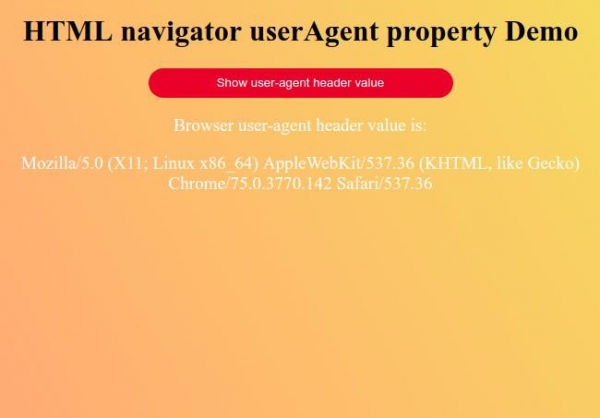
 Data Structure
Data Structure Networking
Networking RDBMS
RDBMS Operating System
Operating System Java
Java MS Excel
MS Excel iOS
iOS HTML
HTML CSS
CSS Android
Android Python
Python C Programming
C Programming C++
C++ C#
C# MongoDB
MongoDB MySQL
MySQL Javascript
Javascript PHP
PHP
- Selected Reading
- UPSC IAS Exams Notes
- Developer's Best Practices
- Questions and Answers
- Effective Resume Writing
- HR Interview Questions
- Computer Glossary
- Who is Who
HTML Navigator userAgent Property
The HTML navigator userAgent property returns the value of the user-agent header sent by the browser to the server.
Syntax
Following is the syntax −
navigator.userAgent
Let us see an example of HTML navigator userAgent property −
Example
<!DOCTYPE html>
<html>
<style>
body {
color: #000;
height: 100vh;
background: linear-gradient(62deg, #FBAB7E 0%, #F7CE68 100%) no-repeat;
text-align: center;
}
.btn {
background: #db133a;
border: none;
height: 2rem;
border-radius: 20px;
width: 330px;
display: block;
color: #fff;
outline: none;
cursor: pointer;
margin: 1rem auto;
}
.show {
font-size: 1.2rem;
color: #fff;
}
</style>
<body>
<h1>HTML navigator userAgent property Demo</h1>
<button class="btn" onclick="display()">Show user-agent header value</button>
<div class="show"></div>
<script>
function display() {
document.querySelector(".show").innerHTML = "<p>Browser user-agent header value is:</p>" + "<p>" + navigator.userAgent + "</p>";
}
</script>
</body>
</html>
Output

Click on “Show user-agent header value” button to display browser user-agent header value −


Advertisements
